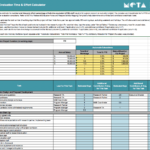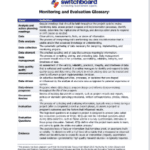Are you working to design a new project or refine the design of an existing program? Switchboard’s Resource Library hosts a variety of project design resources to help guide you through the process.
Strong project design starts with sound logic. Theories of change and logical frameworks (logframes) can both be considered types of logic models. A theory of change diagram explicitly illustrates the causal pathways between activities, outputs, outcomes, and objectives (usually using arrows), while a logframe uses a table or matrix format to summarize the key elements of a project strategy—objectives, outcomes, outputs, and activities—and the indicators and data sources needed to measure them.
Understanding Two Types of Logic Models
- 8 Tips for Using Logic Models to Improve Project Design and Monitoring and Evaluation (M&E), with Case Study (2016)
This tip sheet clarifies the relationship between theories of change and logframes. It provides recommendations for improving your project design, planning for M&E from the start, considering the resources required, and more. Download the accompanying case study to see how logic models helped the staff of a fictional asset-purchase project ensure that their project was based on sound logic and that they could clearly measure their performance. - Why We Should Have Developed our Logic Model before Our Project Narrative — Not the Other Way Around (2017)
It’s tempting to start out program design by drafting a narrative. But when a program’s initial foundation is a narrative description, rather than sound logic, problems can pop up: confusing activities, hard-to-measure indicators, unachievable outcomes and objectives, and difficulty explaining a programs’ results. This blog post uses a real-world example to demonstrate why it’s useful to develop a logic model before a project narrative.
Developing Theories of Change and Logframes
- Developing Theories of Change e-Learning Module (2017)
After completing this 20-minute e-learning module, you will understand what theories of change are; why they are important for strong program design; and how to create a theory of change with your team.
- Developing Logframes e-Learning Module (2017)
After completing this 20-minute e-learning module, you will understand what logframes are; why they are important for strong program design, monitoring and evaluation; and how to develop a logframe.
- Introduction to Program Design: Developing Your Theory of Change (2020) This guide defines “logic model,” “theory of change,” “logical framework (logframe),” etc. and describes the key elements of a strong theory of change.
- 7 Steps for Developing Theories of Change, with Case Study (2016)
Download this tip sheet as step-by-step reference for developing a theory of change. The accompanying case study puts these steps into practice. See how the team for a fictional refugee economic self-sufficiency project developed a theory of change for a program aiming to help clients learn English, gain job search skills, and obtain sustainable employment.
Improving Your Indicators
- SMART Indicators Checklist, with Case Study (2016)
The SMART criteria are a well-accepted way to assess the quality of project indicators (the variables that are tracked to measure changes or achievements in connection with an intervention). Use this checklist to determine if your indicators meet quality standards or need to be revised or discussed further. To see an example of the checklist’s use, download the accompanying case study. It describes the process used by a fictional economic self-sufficiency project team who wanted to ensure that their indicators would enable them and their donor to learn about their project. - Indicator Matrix Template (2016)
An indicator matrix is a tool that goes into more detail than a typical logframe about each of your project’s indicators. This can help you ensure indicators are measurable, realistic and purposeful, improving use of program data down the line. It also clarifies plans for data collection and management, helping to ensure your systems are appropriate and leading to more efficient use of staff time in data collection and analysis.
Want more help with project design? Visit Switchboard’s Resource Library to find many more monitoring and evaluation resources, including tools to help you plan for data collection, management, analysis, and more. You can also receive customized support for your specific project by submitting a technical assistance request to Switchboard!









